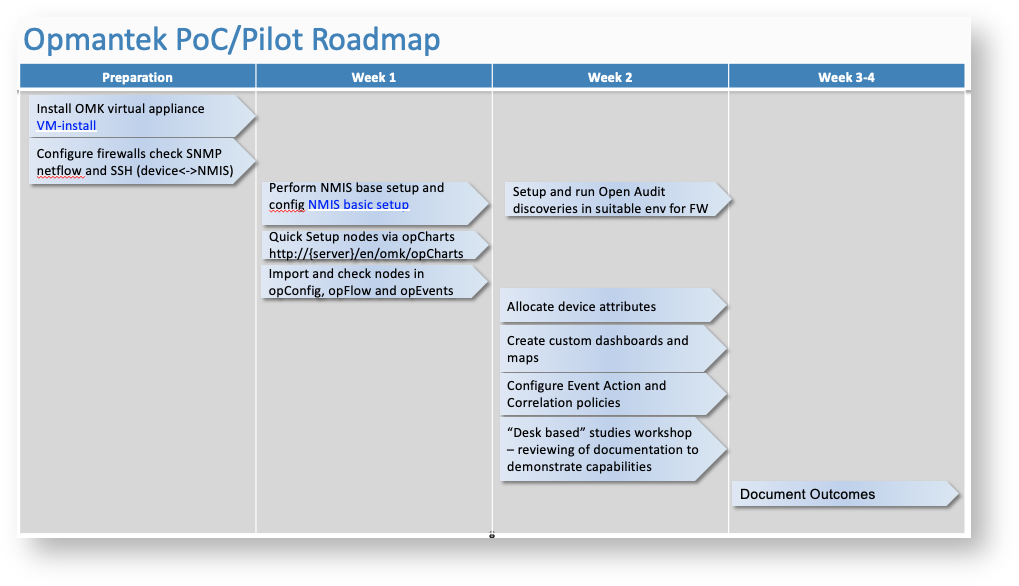Links to Common Questions
Learning about Opmantek's products and capabilities - is a trial the best place for info?
- Opmantek Website and Opmantek Community and Product Documentation
- Webinars and videos
- Presales presentations and live product demonstrations
- How to request large license packs for trials
- What manufacturers does Opmantek NMS support?
- Where can I find product pricing?
Demo vs. Trial vs. PoC vs. Pilot. What are you running?
Trial vs. PoC vs. Pilot
- Trial; Adhoc, small usually run by the customer to discover one of two documented features and familiarize themselves with the product line.
- Proof of Concept (PoC); more defined than a trial, larger with Opmantek engineering support to prove new features
- Pilot; large scale, demonstrating full capability under a commercial agreement
Key aspects of a PoC or Pilot:
Running a PoC or a Pilot cost money for both the customer and Opmantek - both parties should be sure of what they expect to gain and the probabilities.
- Both include a defined and agreed upon scope and timeline
- The purpose of a PoC is to PROVE the concept and to remove any remaining doubt so that an agreement can be completed e.g. confirm a new type of device can be managed.
- A Pilot is really about, yes we agree to proceed and we know your solution works, we need to see it working in our environment and let other people in the company see it to finalize an agreement. A pilot has a defined outcome, e.g. selection approval/purchase order
- Due to the resources involved Opmantek typically charges for running a Pilot vs. a PoC.
What do we need to start?
- Scope of what is to be trialed (the trial checklist)
- What and how many devices
- Which products, features, and use cases to test
- An agreed plan of how we set up and operate the trial
- Staff commitments
- Timelines
- Support process during the trial
- What equipment and environments do we have access to?
Sample Documentation
When conducting a Trial you should start with a list of features or functionality that you feel are necessary in order to ensure the product(s) will meet your needs. Opmantek has prepared the following list as a starting point for you. However, you should decide for yourself what features are important to your organization.
General Requirements
- Hardware, network, and security requirements
- Security; including authentication mechanism, roles and group administration
- Architecture options
- User interface requirements
- Usability and transition between performance, event, and configuration solutions
- Reporting
Network Discovery (Open-AudIT)
Test discovery on a targeted subnet
- Configure to populate NMIS with discovered systems
Performance Management Requirements (NMIS)
- Polling policy; timings and collection policies
- Business policy functions
- KPI Adaptation
- Thresholding and statistics
- Thresholding controls
- Roles based alarm criticality
- NMIS Plugin and Notification system
Data Visualization (opCharts)
- Test creation of Maps
- Topological (both dynamic and static)
- Diagram
- Geographic (both dynamic and static)
- Review combining elements into Dashboards
- Real-time Data Collection
Fault and Event Management (opEvents)
- opEvents' Current Event Views, status, and actionable activity
- Create event Correlation for common device attributes; Location, Customer, Business Service, Role, etc.
- Create Event Actions for common troubleshooting activities and diagnostics
Configuration Management Requirements (opConfig)
- Add credential sets, license devices, and test connectivity
- Review Virtual Operator, configure a custom Quick Action
Example PoC/Pilot Roadmap
